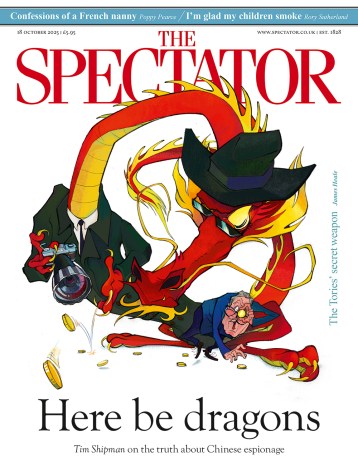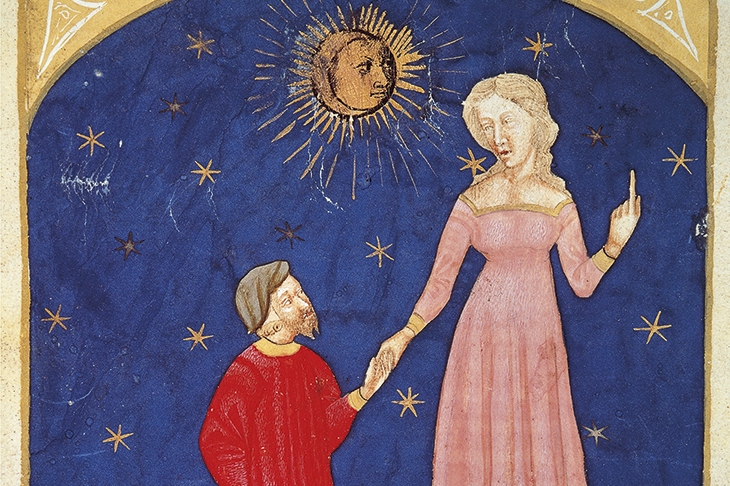As every Italian schoolchild knows, The Divine Comedy opens in a supernatural dark wood just before sunrise on Good Friday 1300. Dante Alighieri, a figure in his own work, has lost his way in middle age and is alone and frightened in the darkness. The ghost of the Roman poet Virgil is about to show him Hell:
Midway in the journey of our life I found myself in a dark wood, for the right path was lost.
Begun in the early 14th century, Dante’s poem is, for many, the greatest single work of western literature. With its dramatic chiaroscuro of hellish fuming mists and paradisal stellar regions, the poem is ‘awful’ in the archaic sense of the word (still valid in the Italian terribile), meaning to inspire awe. With Virgil as guide, Dante journeys through a sulphurous underworld before his ascent to the summit of Mount Purgatory takes him to the revelation of God in Paradise. The poem is called a ‘comedy’, in the medieval-Aristotelian sense that it leads from misery to a state of happiness.
Few translators have been ambitious enough to take on all three books, ‘Inferno’, ‘Purgatory’ and ‘Paradise’, though the late Clive James was an exception. In 2013, he published his version of the tripartite poem with the name CLIVE JAMES blown up to the size of Dante’s on the cover. Like many translators before him, James filled out his Divine Comedy with antiquarianisms (‘whereat’, ‘doth’, ‘aught else’, ‘yonder’), which gave the impression that Dante wrote in an Italian that sounded two centuries old to his first readers.
The Glasgow-born novelist and illustrator Alasdair Gray, who died last year, also dedicated the end of his life to translating Dante’s entire trilogy. Published posthumously, Gray’s Paradise is a work of taut cadence and vigour that captures the drum-beat rhythms and lyric beauty of the original. Daringly, it draws on words and speech patterns of Gray’s native Scotland (‘bairns’, ‘midden’, ‘gloaming’, ‘blethering’), which accord well with Dante’s everyday volgare and make for an adventurous rehabilitation.
A special difficulty for any translator is Dante’s fiendish triple rhyme, known as the terza rima. Not a word in the Italian rhyming tercets is unjustified, unintended or extraneous, so there is little room for error. Unlike Clive James (who put Dante into rhymed quatrains), Gray considers the Dantescan terza rima a stimulus rather than a deterrent, and works with it where possible (he did much the same in his Hell and Purgatory, published in 2018 and 2019 respectively).
For most of his ascent, Dante is accompanied by Beatrice, the ‘sweet darling’ love of his life, who smiles with delight as he soars like a Marvel comic hero. The incredibility of Paradise goes beyond words. In order to communicate the difficulty, Dante invented a verb, trasumanar, meaning ‘to transcend’ or ‘transhumanise’ beyond the human condition. Gray writes: ‘The love-light in the face of Beatrice/ transhumaned me in ways I cannot say.’ Apprehension of the divine Beatrice, no less than of heaven, necessitates a transcendence of human language and comprehension.
Some readers may object to Gray’s more eccentric approximations. Dante mentions two political parties, Ghibelline and Guelf, which Gray translates as ‘Tory’ and ‘Whig’. It just about works. The main difference (as in Britain’s 18th and 19th centuries) was between old and new money, the older class being landowners, the younger one being a nouveaux riches of bankers, traders and merchants.
An indifferent translation might easily resemble the reverse of a tapestry — a frayed and ragged version of the original. Gray’s Paradise, devoid of verbal redundancies and other laxities, amounts to one of the most vital retellings of the poem to date.






Comments